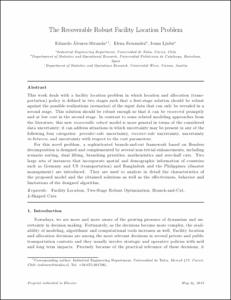Mostra el registre d'ítem simple
The recoverable robust facility location problem
| dc.contributor.author | Alvarez Miranda, Eduardo |
| dc.contributor.author | Fernández Aréizaga, Elena |
| dc.contributor.author | Ljubic, Ivana |
| dc.contributor.other | Universitat Politècnica de Catalunya. Departament d'Estadística i Investigació Operativa |
| dc.date.accessioned | 2015-10-20T12:49:02Z |
| dc.date.available | 2015-10-20T12:49:02Z |
| dc.date.created | 2015-09-01 |
| dc.date.issued | 2015-09-01 |
| dc.identifier.citation | Alvarz, E., Fernandez, E., Ljubic, I. The recoverable robust facility location problem. "Transportation research. Part B, methodological", 01 Setembre 2015, vol. 79, p. 93-120. |
| dc.identifier.issn | 0191-2615 |
| dc.identifier.uri | http://hdl.handle.net/2117/77975 |
| dc.description.abstract | This work deals with a facility location problem in which location and allocation (transportation) policy is defined in two stages such that a first-stage solution should be robust against the possible realizations (scenarios) of the input data that can only be revealed in a second stage. This solution should be robust enough so that it can be recovered promptly and at low cost in the second stage. In contrast to some related modeling approaches from the literature, this new recoverable robust model is more general in terms of the considered data uncertainty; it can address situations in which uncertainty may be present in any of the following four categories: provider-side uncertainty, receiver-side uncertainty, uncertainty in-between, and uncertainty with respect to the cost parameters.; For this novel problem, a sophisticated branch-and-cut framework based on Benders decomposition is designed and complemented by several non-trivial enhancements, including scenario sorting, dual lifting, branching priorities, matheuristics and zero-half cuts. Two large sets of instances that incorporate spatial and demographic information of countries such as Germany and US (transportation) and Bangladesh and the Philippines (disaster management) are introduced. They are used to analyze in detail the characteristics of the proposed model and the obtained solutions as well as the effectiveness, behavior and limitations of the designed algorithm. (C) 2015 Elsevier Ltd. All rights reserved. |
| dc.format.extent | 28 p. |
| dc.language.iso | eng |
| dc.rights.uri | http://creativecommons.org/licenses/by-nc-nd/3.0/es/ |
| dc.subject | Àrees temàtiques de la UPC::Matemàtiques i estadística::Matemàtica aplicada a les ciències |
| dc.subject.lcsh | Numerical analysis |
| dc.subject.other | Facility location |
| dc.subject.other | Two-stage robust optimization |
| dc.subject.other | Branch-and-cut |
| dc.subject.other | L-shaped cuts |
| dc.subject.other | ACCELERATING BENDERS DECOMPOSITION |
| dc.subject.other | OPTIMIZATION PROBLEMS |
| dc.subject.other | LINEAR-PROGRAMS |
| dc.subject.other | UNCERTAINTY |
| dc.subject.other | MODELS |
| dc.subject.other | DISRUPTIONS |
| dc.subject.other | ALGORITHMS |
| dc.subject.other | NETWORKS |
| dc.subject.other | DESIGN |
| dc.subject.other | PRICE |
| dc.title | The recoverable robust facility location problem |
| dc.type | Article |
| dc.subject.lemac | Anàlisi numèrica |
| dc.contributor.group | Universitat Politècnica de Catalunya. GNOM - Grup d'Optimització Numèrica i Modelització |
| dc.identifier.doi | 10.1016/j.trb.2015.06.001 |
| dc.description.peerreviewed | Peer Reviewed |
| dc.subject.ams | Classificació AMS::65 Numerical analysis::65C Probabilistic methods, simulation and stochastic differential equations |
| dc.relation.publisherversion | http://www.sciencedirect.com/science/article/pii/S0191261515001228 |
| dc.rights.access | Open Access |
| local.identifier.drac | 16979005 |
| dc.description.version | Postprint (author’s final draft) |
| local.citation.author | Alvarz, E.; Fernandez, E.; Ljubic, I. |
| local.citation.publicationName | Transportation research. Part B, methodological |
| local.citation.volume | 79 |
| local.citation.startingPage | 93 |
| local.citation.endingPage | 120 |
Fitxers d'aquest items
Aquest ítem apareix a les col·leccions següents
-
Articles de revista [104]
-
Articles de revista [719]


